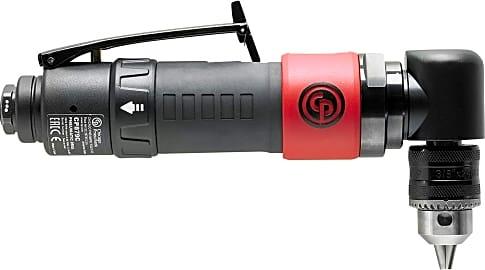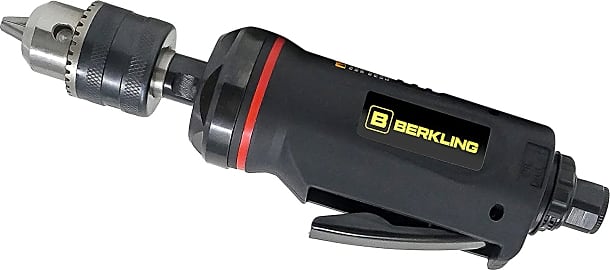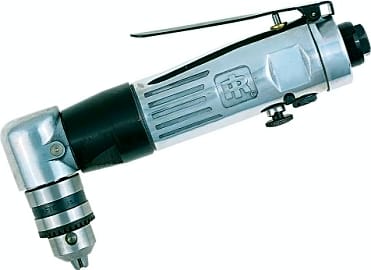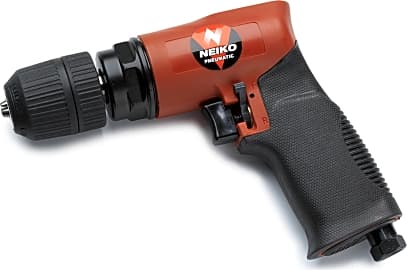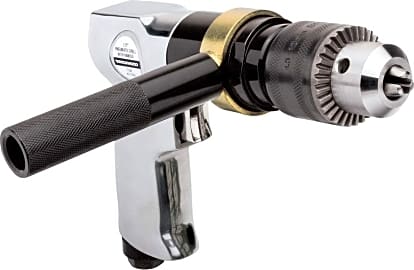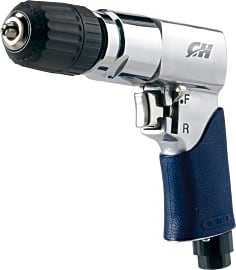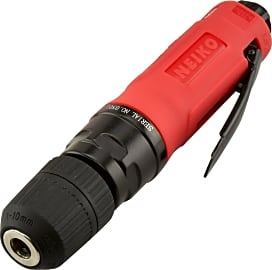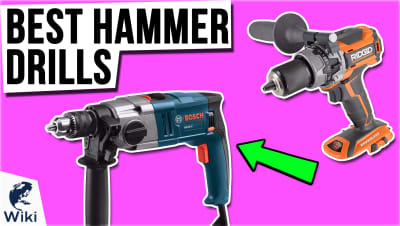The 10 Best Pneumatic Drills

This wiki has been updated 40 times since it was first published in April of 2016. Although they function similarly to their electrically-powered cousins, pneumatic drills harness the power of compressed air to drive screws, bore holes and tighten nuts. Our selections for this category include a range of items, from affordably-priced models that are suitable for the average home garage, to top-end options that are ready to go to work in professional shops. When users buy our independently chosen editorial selections, we may earn commissions to help fund the Wiki.
Editor's Notes
May 10, 2021:
We replaced the Chicago CP9790 and Neiko 30083A with new offerings from their respective companies – the Chicago Pneumatic CP879C and Neiko Pro 30106B – noting that both previous picks were suffering from availability issues and favoring the linear designs of our new choices, believing that our list already included enough pistol-style offerings.
We also eliminated the PanAmerican Tool Corp Nova, which ranked quite high on our list last year, because we felt that there just wasn’t enough user feedback – either positive or negative – to justify this tool’s continued tenure on this list. Last year, it seemed as if there were far fewer well-ranking selections in this space for us to choose from, and so it made sense to give the tool a chance. This year, with many more appealing prospects to pick from, we decided to remove it, in order to make room for some new choices.
We liked the polished aesthetic and knurled side handle on the Rockwood Reversible Gun, and it earned its spot on this list based partially on those merits, but its seven-CFM air demand is considerably higher than most models in the category, which might be more taxing on your air compressor than you'd like, especially if you work in a shop with multiple tools pulling air from the same unit.
The Berkling BT 4538H boasts an impressively quick 22,000-RPM no-load speed, which makes it a better choice than most models on this list when it comes to taking on soft metals and similarly delicate materials. If you like the look of this tool (and with tip-to-tail composite overmolding coating an aluminum-alloy housing, it would be hard to blame you) but you're up against tougher materials, the company also offers a low-speed alternative at a comparable price.
Pneumatic drills can be a great solution for professionals working in shop settings, but their portability is limited, and there’s likely to be times when tripping over an air hose is an inconvenience you just don’t want to deal with. If and when you’re ready to start expanding your drill collection beyond air-powered options, we’ve got plenty of alternate categories for you to browse through, including lists of right-angle drills, hammer drills, rotary hammers, and – of course – good, old-fashioned cordless drills.
January 17, 2020:
During this round of updates, we eliminated the PowRyte Elite and Chicago Pneumatic Mini, due to availability issues, and removed the Central Pneumatic Air Angle after noting how closely it resembled another ranking. We also added several new selections to our list, including the PanAmerican Tool Corp Nova – a smart offering from a Florida-based company that features a rotatable exhaust port, and the DeWalt Reversible DWMT70786L – a powerful model from the well-known brand that’s capable of speeds as high as 2,100 rotations per minute.
A few features to look for while you shop:
Speed Control: While speed control might not be an essential feature for all drilling applications, there’s certainly times when it’s nice – like when trying to control the depth of a new hole, or while sinking the first few threads of a fresh screw. Most of the options we’ve ranked do include some manner of speed control, primarily delivered by variable-speed triggers, but some – like the Grizzly H6362 – don’t. So, if it’s a feature you fancy, make sure that the tool in question is equipped with it before you make your purchase.
Exhaust Systems: Just as electrical circuits (with the exception of purely-resistive-load circuits) require a neutral wire to accommodate return current, pneumatic tools require an exhaust line to expel return air. The problem is, it can be irritatingly noisy. Some models, like the Neiko 30096A have taken steps to mitigate this agitation by integrating mufflers into their tools’ designs. The rotatable exhaust port on the PanAmerican Tool Corp Nova is a nice touch, as it allows you to control the direction of the residual-air blast.
Support Handles: For most applications, a single handle should be more than adequate when wielding these tools. However, the 1/2-inch chucks that commonly come on these models can accommodate some fairly large bits, allowing for some fairly serious drilling and making a secondary handle a fairly good idea. If your plans for this tool include some heavy-duty applications, consider models like the Chicago CP1117P09 Heavy Duty and the Neiko 30083A, which come with adjustable side-mount handles, for supplementary support. It makes ergonomic sense, and you’ll be safer and more comfortable when you’re handling the tool with two hands.
Special Honors
Air Compressors Direct No amount of pneumatic tools are going to do you any good without a decent compressor to power them. This company has hundreds of options to choose from, split among more than a dozen styles, and they make it easy to search by brand, capacity or horsepower rating. aircompressorsdirect.com
Grainger Pneumatic Tools Drills and impact wrenches are a common and logical place to get started with building a pneumatic-tool collection, but that's far from all there is out there. Grainger offers everything from air-powered chisels to chainsaws, and they make it conveniently easy to sort by price. grainger.com
Breathe In, Breathe Out
Even before pneumatic tools came around, scientists like John Wanamaker and Alfred Beach demonstrated how effective tubes are at moving not just the mail, but even people.
In the year 1650, famed German physicist Otto Von Guericke paved the way for air compressors when he invented a vacuum pump to help him study pressure and combustion. Additional engineers would release upgraded designs in the coming decades, until the first compound compressor was invented in 1829. Even before pneumatic tools came around, scientists like John Wanamaker and Alfred Beach demonstrated how effective tubes are at moving not just the mail, but even people. By the middle of the 19th century, compressed air had broken into worldwide industry during the digging of the Mount Cenis Fréjus Rail Tunnel, and the stage was set for the popularization of pneumatic tools. In 1871, Simon Ingersoll of historic manufacturer Ingersoll-Rand released the steam-powered rock drill, the precursor to today's jackhammers, and the first publicly available, air-powered tool.
Over the next 100 years, improvements in cooling, power consumption, storage capabilities, lubrication, and more all came together to help turn air tools into some of the most useful implements ever made for construction and demolition.
The Pros And Cons of Air Tools
There are various reasons why pneumatic tools have earned a special place in the hearts and workshops of engineers, builders, and mechanics worldwide. One of their defining characteristics is the strength of both their materials and their output. Air tools are well known for delivering massive amounts of torque, able to successfully free rusted nuts, drill through high-strength steel, or shatter foot-thick concrete. And because they're driven by simple compressed air, that high level of force is variable. That way, if you're working with a more sensitive piece of equipment, a little bit of pressure release will ensure that nothing takes any damage. Since they don't contain batteries or drivetrains of any sort, pneumatics are often lighter than their electric counterparts, and ease of use means a whole lot if you're disassembling a dozen vehicle undercarriages per day. The newest options have even added Bluetooth support, to help parse and organize the data surrounding your latest project. Finally, the air tools themselves are significantly less costly than electric versions would be, because they all share the same power source.
Unfortunately, that power source is somewhat of a drawback to pneumatics. One thing that no one has addressed very effectively is the incredible noise of a strong compressor. And though they're usually long-lasting, multipurpose appliances, they can be wildly expensive, especially the most reliable brand names and feature-packed models. Plus, even the mid-range models require regular maintenance to ensure proper and safe operation. Of further contention is the air hose, ever so stiff and leaky. The solid nature of a hose under high pressure can make it challenging to maneuver around busy garages or tight projects, and even the best ones are liable to develop faults somewhat quickly.
Which One do I Need?
You may hear the term "pneumatic drill" used to describe one of a couple different items. Particularly in Europe, it's long been a synonym for the jackhammer. This is a bit misleading, because in this sense, the drill doesn't really drill at all, but rather jabs a high-impact steel tip downward to demolish whatever is beneath it — usually solid rock, concrete, or asphalt. These monstrous tools are almost exclusively meant for professionals, and the average DIY enthusiast should probably avoid them. But if you're fixing foundations, installing a new driveway, or clearing away space-hogging rocks, it may be something you need to consider.
A simple, air-driven drill will fulfill a lot of hobbyist needs, and they're generally among the least expensive ways to go.
Taken at face value, the term could simply refer to a drill that's pneumatically powered. And within that classification there are still more choices to make. A simple, air-driven drill will fulfill a lot of hobbyist needs, and they're generally among the least expensive ways to go. On the other hand, anyone with heavy construction tasks like sinking anchors in concrete should look into purchasing a rotary hammer. These ultra-powerful designs spin a chisel while using pressurized air to literally bring the hammer down on top of the rotating bit. This has the effect of ripping into concrete or stone while also carving away material, leaving a relatively clean hole rather than a pile of shattered rock.
Yet another type of air-powered drill is alternately called the impact hammer or impact drill. Shaped roughly like a traditional handheld drill, this type stores kinetic energy in an internal rotating mass, which is suddenly and repeatedly harnessed to deliver massive force in one circular direction or the other. These you'll find at auto shops and racetracks, extracting lugs nuts in two seconds or less with an unmistakable zipping sound. Their sudden rotational force helps them liberate some of the most frozen nuts and bolts — if an impact hammer can't break it free, it's probably time to just drill it out.
A slightly smaller type of impact hammer, the impact driver, looks a bit like a simple pneumatic screwdriver next to its other, larger cousins. While such screwdrivers are available, the impact driver actually tends to pack more punch than it appears to, and it's easy to move around with thanks to its light weight.
Each of these types of pneumatic drills are focused on specific tasks, so you may end up with more than one of them. But that's okay; air tools are exceptionally resilient, and generally make good investments. Plus, considering the stone-shattering levels of torque that come in an essentially handheld package, there's at least a little fun to be had in exercising the power of power tools.
As with any such implements, always take the necessary safety precautions. Make sure all lose clothing and hair is contained, and don't forget personal protective equipment such as gloves, ear protection, and safety eye wear. In fact, if you're using any of these any work, it's entirely possible that your employer will require OSHA-approved glasses, and that's not a bad thing. Safety and living to build another day are always of prime importance.


